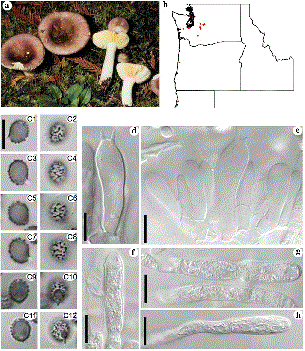Russula pseudotsugarum Bazzicalupo, D. Miller & Buyck.
Index Fungorum number: IF553821 Facesoffungi number: FoF 03654
Etymology: refers to its presumed association with Pseudotsuga.
Holotype: Woo BW953 (WTU, sub nr. F-038562)
Pileus 3–8(–16) cm diameter, convex, becoming gently depressed in the centre, never deeply funnel-shaped, with shortly striate margin; very variable in colour, greenish, flesh-coloured to pinkish red, vinaceous to ruby red, reddish purple, violet brown to brown, even uniformly dark purple, mostly with distinctly darker centre. Lamellae adnate, equal or with an occasional lamellula or bifurcation, normally spaced (ca. 1 L/mm), becoming distinctly yellowish; gill edge even, concolourous. Stipe cylindrical or more often widening downward, variable in length, and both distinctly longer or shorter than the cap diameter, slender to distinctly inflated, often also bent in its lower part, white. Context fragile, white, unchanging, insensitive to FeSO4 (~20% of Woo specimens recorded as tan or yellow). Odor none. Taste mild in gills and flesh. Spore print cream to yellow (~25% Crawshay D–E, ~75% Crawshay F–G). Spores broadly ellipsoid, (6.25–)8.07–8.13–8.18(–10.6) × (4.7–)3.31–6.35–6.39(–8.1) µm, Q = (1.2–)1.27–1.28–1.29(–1.6); ornamentation (sub)reticulate, with amyloid warts, (0.2–)0.59–0.6–0.61(–1) µm high, fused in short crests or with thin interconnections; suprahilar spot present as a distinct amyloid patch. Basidia (23–)32–38–43.5(–56) × (9–)10–11–12(–13.5) µm, 4-spored, stout and slightly clavate; basidiola similar. Lamellar trama composed mainly of sphaerocytes, intermixed with cystidioid hyphae. Hymenial cystidia 60–65 × 9–11 µm, clavate to fusiform, thin–walled, weakly SV+ and pale grey in sulfovanillin (~20% of Woo specimens recorded as maroon or pink). Marginal cells not differentiated. Pileipellis not sharply delimited from the underlying context of filamentous hyphae and sphaerocytes; suprapellis composed of loosely arranged hyphae with cylindrical terminal cells having obtuse tips. Pileocystidia at pileus surface measuring (23.5–)27–31–35.5(–41.5) × (4–)5–6–7.5(–9) µm, septate, with short terminal cells, often somewhat clavate or inflated, obtuse–rounded at the tip; contents refringent. Acidoresistant incrustations absent. Clamp connections absent in all parts.
Habitat and distribution: although Pseudotsuga menziesii was present at each collection locality, other conifers such as Tsuga heterophylla, Picea stichensis, and Pinus contorta were usually present as well.
Examined material: U.S.A., Washington, Chimacum County Park, 48˚0’53” N; -122˚46’39” W, 40 m alt., 11 Nov 2001, B. Woo BW951, F-038563 (WTU), GenBank ITS2: KX813576; ibidem, Greenwater Road 70, 1176 Trailhead, 121.619167˚W, 47.140278˚N, 600 m alt., 10 Sep 1995, B. Woo BW597, F-038602 (WTU), GenBank ITS2: KX81331809; ibidem, Oct 2005, B. Woo BW1041, F-038641, GenBank ITS2: KX812940; Old Fort Townsend Jefferson County, 122.790556˚W, 48.074˚N, 60 m alt., 29 Oct 1998, B. Woo BW767, F-038908 (WTU), GenBank ITS2: KX813433; ibidem, 11 Nov 2001, B. Woo BW953, F-038562 (WTU, holotype), GenBank ITS2: KX813578; ibidem, Olympia, Priest Point Park, 122.8961˚W, 47.06972˚N, 30 m alt., 02 Nov 1998, B. Woo BW786, F-038887 (WTU), GenBank ITS2: KX813447; ibidem, Talapus Lake Trailhead FS road 9030, 121.585˚W, 47.401˚N, 805 m alt., 05 Oct 2005, B. Woo BW1035, F-038628 (WTU), GenBank ITS2: KX812934; ibidem, Olympia, Tolmie State Park, 122.7761˚W, 47.120556˚N, 2 m alt., 11 Nov 1999, B. Woo BW849, F-039125 (WTU), GenBank ITS2: KX813499.
Notes: Russula pseudotsugarum corresponded to Clade 8 in our phylogeny, to Woo sp. 52 in Bazzicalupo et al. (in press) and to UNITE SH DOI: https://plutof.ut.ee/#/datacite/10.15156/BIO/SH315582.07FU.
All 25 samples of Russula pseudotsugarum formed a monophyletic group nested within a well-supported clade that included R. cessans Pearson, R. zelleri Burl., Woo sp. 51, R. laricina Velenovsky and R. nauseosa. The European R. olivina Ruotsalainen & Vauras, well characterized by its two-spored basidia and particular spore ornamentation, considered as a close relative to these species in Sarnari (1998-2005), was only distantly related in the phylogeny. Russula pseudotsugarum will be difficult to separate morphologically from R. zelleri and R. obscurozelleri, but as its name suggests, it has been found consistently with Pseudotsuga, while R. zelleri is found with Picea.
Russula pseudotsugarum has probably been identified as R. lilacea in the Pacific Northwest based on the Grund (1965) key, but R. lilacea may not occur in the region. Russula pseudotsugarum could easily be confused with R. obscurozelleri (Clade 7); see notes under that species.
Geographically, samples with sequences identical to R. pseudotsugarum ranged from the Pacific Northwest to Mexico: Canada: Sooke Reservoir, Vancouver Island, BC (UDB031541); Bella Coola, BC (HQ650754); Pemberton, BC (JN652960); Campbell River, BC (KP403052, KP403055); BC (KM402893, KP406550, KP406553, KT272154, KT272155); Mexico: Tlaxcala (KP781012) USA: Mt St Helen, Washington (UDB012199); HJ Andrews Experimental Forest, Cascade Range, Oregon (EU526011); California (JF834345, JF834494).
Sequences1.5% different from R. pseudotsugarum were recorded from western and eastern North America and Europe, likely representing R. zelleri, R. cessans, and R. laricina: https://plutof.ut.ee/#/datacite/10.15156%2FBIO%2FSH177309.07FU.

Maximum likelihood phylogeny of nine new species of Russula. Specimen codes and morphological descriptions are available through <http://advance.science.sfu.ca/fungi/index.php?-link=Home>. Bootstrap support 70% or more is indicated by thickened black branches. The grey shading of taxa indicates the samples of the new species described. Holotypes are designated along with their collection numbers and GB accessions. Clade numbers are assigned to new species and the total number of Woo’s collections of each new species is in parentheses. ‘CT’ next to taxon name indicates the sample was confirmed with a type specimen sequence; an asterisk ‘*’ indicates a sample from the backbone constraint tree. GenBank sequences R. aurea, R. leprosa, R. sardonia, R. rosea, and R. pseudointegra were re-named in this figure based on recent sequencing of the species by author BB.

Morphology and specimen distribution of Clade 8 Russula pseudotsugarum (Woo sp. 52). BW followed by numerals designate Ben Woo samples. a Photo by B. Woo, BW953, scanned image from WTU. b Distribution of specimens of the Woo collections in Pacific Northwest States and Provinces. c–h Micromorphology, all 1000x magnification. c Spores in median optical section and surface view in Melzer’s reagent (c1–c2, BW767; c3–c4, BW767; c5–c6, BW786; c7–c8, BW786; c9–c10, BW953; c11–c12, BW953). d–e Basidia (BW951, BW1041). f–h Cap cuticle terminal cells with refringent contents (BW849, BW1035, BW1035). Scale bars 10 µm
